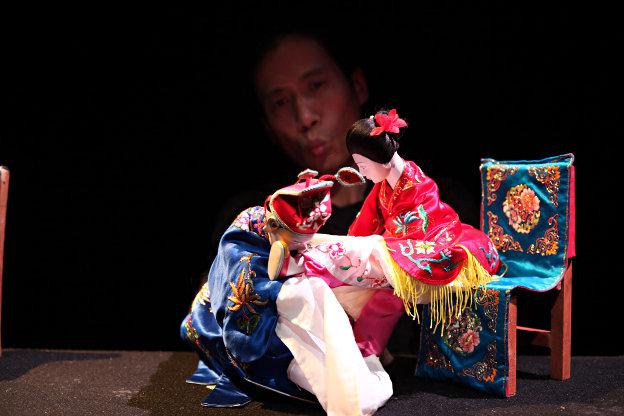Asian countries with a strong puppet tradition, such as Indonesia, Japan and China, have for some years worked on a modern approach to their theatre, but have found the international demand for their traditional shows a heavy drag on new creations.
Yeung Fai has found a highly intelligent way to shake off the cobwebby aspects of the Chinese glove puppet tradition while retaining some of its magic. He has invented a show full of humour and self-parody that mixes media in a context of ‘stories’, semi-autobiographical episodes which yet allow him to amaze us with reminders of traditional shows by displaying his fabulous dexterity. The Chinese brilliance of manipulation, especially of glove puppets, is virtually unknown among Western puppeteers, and is the result of a mental and physical training that began when Yeung Fai was six years old. He is a fifth-generation puppeteer, and has broken the mould. I imagine some of his ancestors are revolving indignantly in their grave.
The transgression starts with the visibility of the two excellent performers (the second is French, I believe, and his name is Yoann Pencolé), who are as much actors as puppet players. Then there is projection and film: a rupture with tradition, obviously. Several changes of scene and good lighting effects shift the action all over the stage, with a long strip of cloth hung at the back for the projections. The most striking innovation is in the dramaturgy which refers to a 20th Century world: episodes in the life of the puppeteer and his family. Then there are the puppets: three of them larger than the usual tiny figures (also present from time to time), with realistically sculpted features; another a cute angel with pop-up wings; another a big shiny dragon, about two metres long, writhing menacingly above the tabletop staging.
The dragon represents a malevolent power, dominating grim episodes about an imprisoned man hit on the head by a Little Red Book (the Cultural Revolution had a dreadful effect on Yeung Fai’s family). Another episode shows an impoverished street puppeteer, Yeung Fai himself, performing what he has salvaged of his traditional show to the unheeding passers-by.
Otherwise the sketches are lighthearted, witty, varied, with some spoken banter in Chinese and French between the two players. The playing area for the puppets consisted of one, sometimes two, plain, heart-high wheeled counters; turned around, one of the counters revealed a cramped hut built into the back, where the puppeteer was visited by the cute angel, apparently symbolising Hope.
I was well entertained, and would gladly see it again, to revisit the rich pleasures of the visuals and the funny, touching storytelling.


